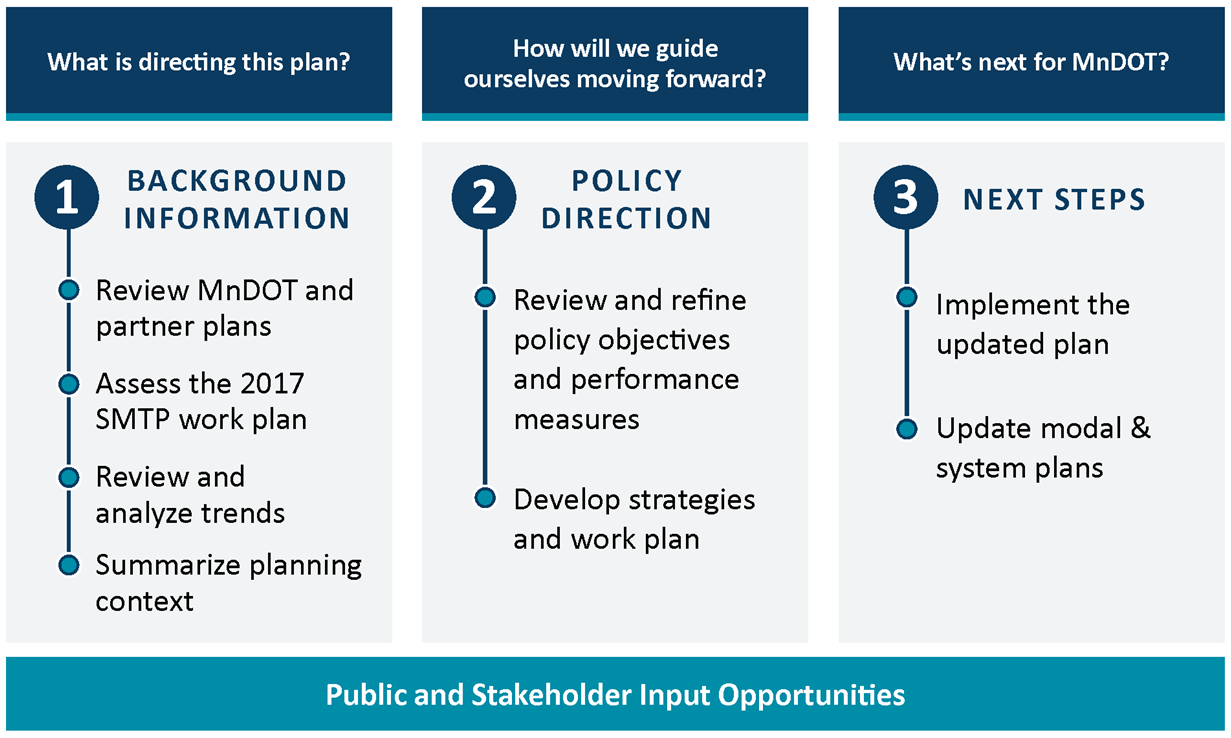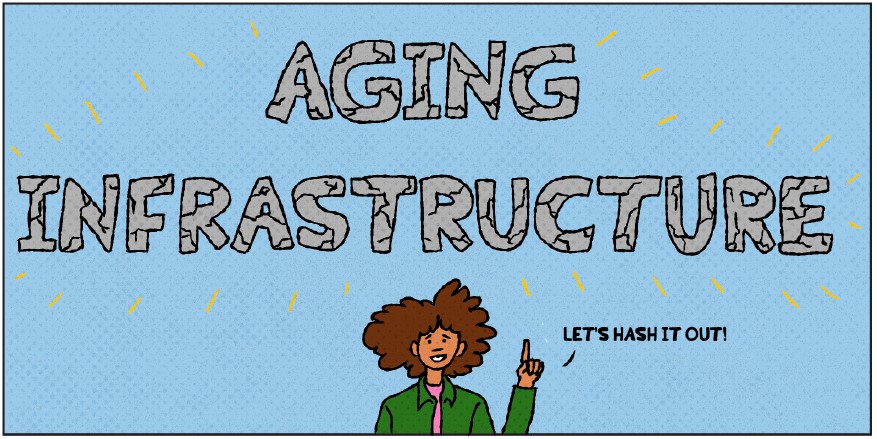2022 SMTP Table of Contents
Chapter 1
What are we trying to achieve
The Statewide Multimodal Transportation Plan (SMTP) is Minnesota’s highest level policy plan for transportation. It is a 20-year plan based on the Minnesota GO Vision for a transportation system that maximizes the health of people, the environment and our economy. It supports the 16 goals for transportation established by the Minnesota Legislature. The plan is for all types of transportation and all transportation partners. It is about more than just roads and more than just the Minnesota Department of Transportation (MnDOT). The plan takes into account what is changing for the transportation system and provides direction for progress over the next 20 years.
Minnesota GO Vision
The transportation system is built to move people and goods, ensure a high quality of life for Minnesotans and support our economy. In 2011, MnDOT created the 50-year Minnesota GO Vision to set guiding principles for everyone with a role in making the transportation system work for Minnesotans. The vision says that “Minnesota’s multimodal transportation system maximizes the health of people, the environment and our economy.” It answers the question, “What are we trying to achieve with transportation over the next 50 years?” See Figure 1-1 for the Minnesota GO Vision and guiding principles.
The SMTP is the 20-year plan that sets policy direction for the modal and system plans that make up the statewide transportation plan (i.e., Family of Plans). The state requires the SMTP to be updated every five years. The SMTP and the other plans in the Family of Plans combined meet state and federal transportation planning requirements. These plans must support national, state and local goals. See Appendix K – Planning Requirements to see how the SMTP meets state and federal planning requirements.
Figure 1-1: Minnesota GO Vision and guiding principles
MINNESOTA'S MULTIMODAL TRANSPORTATION SYSTEM MAXIMIZES THE HEALTH OF PEOPLE, THE ENVIRONMENT AND OUR ECONOMY.
The system:
- Connects Minnesota’s primary assets—the people, natural resources and businesses within the state—to each other and to markets and resources outside the state and country.
- Provides safe, convenient, efficient and effective movement of people and goods.
- Is flexible and nimble enough to adapt to changes in society, technology, the environment and our economy.

QUALITY OF LIFE
- Recognizes and respects the importance, significance and context of place—not just as destinations, but also where people live, work, learn, play and access services
- Is accessible regardless of socioeconomic status or individual ability

ENVIRONMENTAL HEALTH
- Is designed in such a way that it enhances the community around it and is compatible with natural systems.
- Minimizes resource use and pollution.

ECONOMIC COMPETITIVENESS
- Enhances and supports Minnesota’s role in a globally competitive economy as well as the international significance and connections of Minnesota’s trade centers.
- Attracts human and financial capital to the state.
Goals for transportation in Minnesota
Minnesota statute 174.01 identifies 16 goals to ensure Minnesota has an integrated multimodal transportation system. The 16 goals are:
- To minimize the fatalities and injuries for transportation users throughout the state.
- To provide multimodal and intermodal transportation facilities and services to increase access for all persons and businesses and to ensure economic well-being and quality of life without undue burden placed on any community.
- To provide a reasonable travel time for commuters.
- To enhance economic development and provide for the economical, efficient and safe movement of goods to and from markets by rail, highway and waterway.
- To encourage tourism by providing appropriate transportation to Minnesota facilities designed to attract tourists and to enhance the appeal, through transportation investments, of tourist destinations across the state.
- To provide transit services to all counties in the state to meet the needs of transit users.
- To promote accountability through systematic management of system performance and productivity through the utilization of technological advancements.
- To maximize the long-term benefits received for each state transportation investment.
- To provide for and prioritize funding of transportation investments that ensures that the state’s transportation infrastructure is maintained in a state of good repair.
- To ensure that the planning and implementation of all modes of transportation are consistent with the environmental and energy goals of the state.
- To promote and increase the use of high-occupancy vehicles and low-emission vehicles.
- To provide an air transportation system sufficient to encourage economic growth and allow all regions of the state the ability to participate in the global economy.
- To increase use of transit as a percentage of all trips statewide by giving highest priority to the transportation modes with the greatest people-moving capacity and lowest long-term economic and environmental cost.
- To promote and increase bicycling and walking as a percentage of all trips as energy-efficient, nonpolluting and healthy forms of transportation.
- To reduce greenhouse gas emissions from the state’s transportation sector.
- To accomplish these goals with minimal impact on the environment.
Family of Plans
The objectives, performance measures, strategies and actions in the SMTP set policy direction for MnDOT’s modal and system plans. This set of plans include aviation, bicycle, freight, highway, pedestrian, ports and waterways, rail and transit. These plans are collectively known as the “Family of Plans.” Together the Family of Plans directs investments, maintenance, operations, modal programs and services for all types of transportation throughout the state. Other plans for safety, accessibility, operations, technology and more can but are not required to follow the SMTP’s policy direction.
SMTP update process
MnDOT is responsible for working with the public, transportation partners and tribal nations to produce the SMTP. Throughout the update process, MnDOT sought input from the public, stakeholders and partners. A summary of the engagement process and input received is included in Chapter 4. A detailed public engagement report is available in Appendix G – Engagement Summary. The plan update process is shown in Figure 1-2.
Figure 1-2: Statewide Multimodal Transportation Plan process

STEP 1. BACKGROUND INFORMATION
The SMTP process began with a review of plans and studies completed in the last five years and changes in law and policy since 2017. Staff evaluated the progress made in implementing the 2017 SMTP. Insights from these reviews highlighted where MnDOT could make updates to the trend library.
Chapter 2 provides a snapshot of the current transportation system. Chapter 3 includes a high-level summary of trends impacting the transportation system. More background information is included in the appendices.
STEP 2. POLICY DIRECTION
Based on insights from step 1, MnDOT reviewed and updated the objectives and strategies to ensure they aligned with the Minnesota GO Vision and current transportation policies. Actions were developed to clarify how to implement each strategy. Additionally, performance measures were updated for each objective based on the draft policy direction. The updated objectives, performance measures, strategies and actions are listed in Chapter 5.
STEP 3. NEXT STEPS
This work is expected to happen over the next five to 20 years after the plan is adopted and will focus on the implementation of the policy direction set forward in Chapter 5. Chapter 6 contains the list of activities MnDOT will do in the next five years, known as the SMTP Work Plan. Additionally, each of the Family of Plans will be updated to align with the SMTP policy direction. Chapter 7 identifies partner roles, change readiness considerations and implementation essential practices to move Minnesota’s transportation system forward.
FOCUS AREAS
This update of the SMTP focused on six areas for transportation in Minnesota—aging infrastructure, climate, economy and employment, equity, safety and transportation options. These were selected in collaboration with the public, stakeholders and partners as part of SMTP engagement. These focus areas cut across all transportation topics and guide priorities for the transportation system.

AGING INFRASTRUCTURE: Infrastructure across the country is aging. As the system ages, more resources go to maintenance and repairs to make sure they serve communities as intended. Minnesota’s transportation system shows signs of deterioration and requires attention.

CLIMATE: Minnesota’s climate is already changing. Temperatures are increasing and larger, more frequent extreme weather events are occurring year round. Climate change will impact the way the transportation system is used, built, designed, operated and maintained. The transportation sector needs to combat climate change by providing people with environmentally friendly choices to ensure their daily transportation needs are met.

ECONOMY & EMPLOYMENT: The transportation system works best when it evolves to meet the needs of people and the changing economy. Understanding these needs helps ensure that people and goods move safely and efficiently throughout Minnesota. The future requires collaborative solutions that support the economy and employment as an essential goal for the transportation system.

EQUITY: Decisions on policy, design and operations in the built environment and transportation system have led to inequities for underserved communities, especially Black, Indigenous and People of Color. Advancing transportation equity requires having a better understanding of how the transportation system, services and decision-making processes help or hinder the lives of people in underserved communities in Minnesota.

SAFETY: Recent shifts in transportation behavior have led to a significant step backwards in transportation safety. 2021 was the deadliest year on Minnesota roads in more than a decade. A mix of traditional and new practices and methodologies are needed to prevent and mitigate human error and ensure people are safe.

TRANSPORTATION OPTIONS: A variety of transportation options support how people and goods move across the state, throughout a region or within a community. Collaboration with all partners is required to ensure a connected transportation system offers options and choices for moving people and goods.
A renewed commitment
This SMTP update continues the last five years of planning activities. It provides a revised set of strategies to advance the Minnesota GO Vision to continue the work set forward by the 2017 SMTP. Actions are a new level of detail to the policy direction to provide clarity on how to meet the commitments in the vision and who has a role in implementing this work.
Since the 2017 plan, there are new opportunities and challenges. Progress has been made toward the Minnesota GO Vision. This update renews the state’s commitment to the vision, but it will take all partners to bring the vision to a reality. The challenges Minnesota is facing require bold, coordinated approaches. Collective commitment is needed from all who have a role in making transportation work for Minnesotans. Consider the policy direction in this SMTP an invitation to join MnDOT and transportation partners to build this bold new transportation future together.
